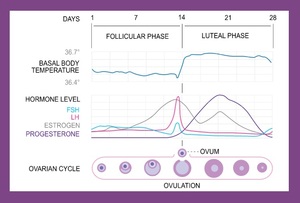During the years I worked as a volunteer helping women with polycystic ovary syndrome in my home state find information, doctors and support, I learned a lot about all sorts of infertility. There were a few women who contacted our group for information not because they ovulated too infrequently, as is typical in most women with PCOS, but because their menstrual periods came too close together and they, too, were having trouble getting pregnant. One might think that ovulating more often would increase your chances at pregnancy, but I learned that a cycle that is too short can be a sign of a condition called a luteal phase defect. What surprised me was that even if you have a perfect 28-day cycle, if the phases are off you could have a luteal phase defect, too.
Luteal phase defect is a big, scary medical term that, put simply, means a problem with the second half of the menstrual cycle. The first half of a woman’s menstrual cycle begins on day one of her menstrual period, a very identifiable day, and ends on the day of ovulation. It is harder to detect precisely when ovulation occurs without using an ovulation predictor kit or tracking your basal body temperature, but those who are trying to conceive usually learn how to identify this day. The second half of the menstrual cycle, beginning on the day of ovulation and ending on the first day of the next menstrual period, is called the luteal phase. If this phase is out of whack, a woman can have a very hard time becoming pregnant.
Recognizing a luteal phase defect requires that you know your cycle well. You must know when ovulation occurs in order to know if the luteal phase is too short. The luteal phase of a menstrual cycle should be about 12 to 14 days long. If it is shorter than that, pregnancy is unlikely to occur. Thankfully, once a luteal phase defect is suspected, it can usually be diagnosed and treated by a knowledgeable doctor.
According to INCIID, the InterNational Council on Infertility Information Dissemination, a luteal phase defect can be caused by a number of factors. Depending on the cause of the defect, the treatment may vary. Several causes may result in the same symptom, but a doctor can usually determine which issue is causing a luteal phase defect. Some women have poor follicle development in the first half of the menstrual cycle. Others experience an early failure of the corpus luteum, or yellow body which forms after the follicle releases the egg and is responsible for producing progesterone during the second half of the menstrual cycle. Still others have good follicle development and a functioning corpus luteum, but their uterine lining fails to respond correctly to the body’s progesterone.
Besides treatments that your doctor may prescribe, which may include a drug like Clomid to improve follicle development or progesterone in the second half of your cycle to improve uterine conditions, you can also make changes in your lifestyle which may help. Eating foods rich in progesterone, like wild yam and walnuts can help. Other foods rich in zinc and vitamin B6 can also help boost progesterone production. Reducing stress and engaging in physical exercise have also both been shown to improve progesterone levels.
A luteal phase defect can be one of the easier forms of infertility to treat once it is diagnosed. One of my friends was diagnosed and treated with progesterone cream in the second half of her cycle and conceived within three months. If you are having trouble conceiving, make sure and see your doctor. You may be referred to a reproductive specialist, who will be best equipped to treat this and any other problems interfering with your ability to conceive.
More by Tavia:
Old-Fashioned Thinking Yields IVF Breakthrough
Shooting Free Throws to Lose Weight
How Does Orgasm Relieve Menstrual Cramps?




